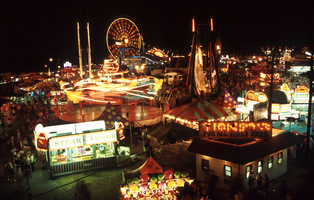 | Back to e-WV
| Back to e-WV
 The West Virginia Encyclopedia
The West Virginia Encyclopedia
 | Back to e-WV
| Back to e-WV
 The West Virginia Encyclopedia
The West Virginia Encyclopedia

Thousands of people pour into the Greenbrier Valley every August to attend the State Fair of West Virginia in Fairlea. The origins of this multi-day event date back to smaller fairs at various locations in the 1800s. The Greenbrier Agricultural Society hosted its first annual fair on land in what is now downtown Lewisburg in 1854. The fair now known as the West Virginia State Fair was founded by cattlemen of the Shorthorn Association as the Greenbrier Valley Fair in 1921. The state fair has other roots, as well, particularly including the big fair held on Wheeling Island in the late 19th and early 20th centuries. The Wheeling fair variously identified itself as the West Virginia State Fair and the West Virginia Exposition and State Fair and apparently was discontinued due to the periodic flooding of the island.
The 1921 Greenbrier Valley Fair was held at the site of today’s fairgrounds and introduced the annual tradition of competitive exhibits from boys’ and girls’ 4-H agricultural clubs. Admission was 75 cents for adults that year. An old railroad track was cleared and a half-mile horse racetrack built by the Shorthorn Association. Stables, barns, a grandstand, a stage, and an exhibit building were erected over the next few years. The state legislature proclaimed the event the State Fair of West Virginia in 1941, but the fair actually is owned by local stockholders, not the state. The governor and the commissioner of agriculture are ex officio members of the 13-member board of directors.
The gates to the newly designated state fair did not reopen until 1946, after the conclusion of World War II. Because of an outbreak of measles, many parents came to the fair that year without their children.
Nationally known acts have been appearing at fairs in the Greenbrier Valley since at least 1892, when a daredevil equestrian show gave daily performances. Since the inception of the State Fair of West Virginia, entertainers have included Roy Rogers and Dale Evans, Johnny Cash and June Carter Cash, Tom Jones, Dolly Parton, Randy Travis, the Beach Boys, Alison Krauss, and, in more recent years, acts from Nelly, to Ludacris, to Kathy Mattea.
Today’s fair continues the decades-long traditions of competitive and educational agricultural exhibits, harness racing, carnival rides and games, musical shows, fireworks and other entertainment, and concessions.
The State Fair museum is housed in Meriluco, a cottage constructed in 1928 by the Meadow River Lumber Company of Rainelle. Named from the first two letters of each word in the company’s name, Meriluco was built as a sales showcase for house trim, moldings, and flooring. Over the years, the building served such functions as the fair’s post office and the Greenbrier County Sheriff’s headquarters at the fair. Meriluco, added to the National Register of Historic Places in 1997, is one of many attractions on the State Fair grounds.
Read the National Register nomination for Meriluco, the Meadow River Lumber Building.
Written by Belinda Anderson
Anderson, Belinda. Going to the State Fair with the Tuckwillers. Goldenseal, (Summer 1999).
State Fair of West Virginia: 75 Years: West Virginia's Finest Tradition Continues. Wonderful West Virginia, (Aug. 1999).